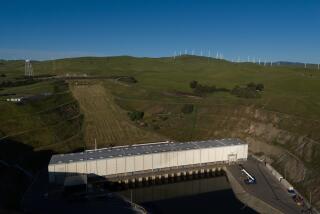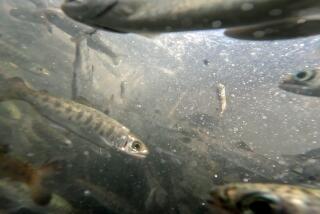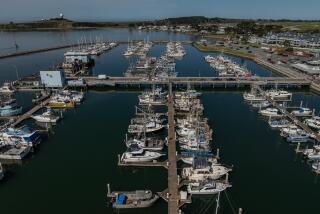Moving Oil Slick Sets Back Effort to Save Salmon
VALDEZ, Alaska — A new setback in the 16-day war to manage the nation’s largest oil spill was dealt Saturday to two major salmon hatcheries.
State officials said an advancing oil slick, created when the 987-foot tanker Exxon Valdez ran aground on March 24, has been spotted moving into a heretofore untouched northwestern section of Prince William Sound where the largest salmon hatchery is located.
At the same time, officials said a long-awaited large containment boom sent in by the Navy to reinforce an oil barrier at the entrance to another major salmon hatchery at Port San Juan to the south may not do the job.
They said the “skirt” on the boom that reaches below the surface to block the oil’s path beneath it is not 42 inches deep as expected but only 24 inches deep.
“That would severely impact its effectiveness if we were to have a southeastern storm,” Dennis D. Kelso, Alaska commissioner of environmental conservation, said Saturday.
Kelso said he did not know why the state had been misinformed but said that he had earlier been assured by the U.S. Coast Guard that the skirt would be 42 inches deep. He said the Coast Guard got its information from the Navy.
The double setback came as fishermen and others kept a watch on weather reports. So far, the sun has continued to shine and the seas have been calm.
But a significant storm could defeat the efforts mounted so far. The likelihood of a major storm had prompted the order for the larger sea boom.
“We’ve been aided by unusually good weather conditions,” said Bruce Suzumoto of the nonprofit Prince William Sound Aquaculture Corp., which operates the hatcheries.
Surprised by Slick
The discovery of the new slick, located in Perry Passage about five miles from the Ester Island hatchery, came as a surprise.
The Ester Island hatchery produces 300 million salmon fry--or tiny young fish--each year and is the largest single hatchery of the five located in Prince William Sound. Among them, they earn $50 million annually and produce 750 billion eggs each year.
The slick was spotted by Marshal Kendziorek of the state Department of Environmental Conservation during a flight over the area late Friday.
“Personally I was very upset. It’s a very special place,” Kendziorek said.
The situation at Port San Juan hatchery was compounded by equipment problems.
Rear Adm. Edward Nelson Jr. flew Saturday by Coast Guard helicopter to Sawmill Bay and eventually went by boat to nearby Port San Juan. When he arrived there, he learned that workers were forced to halt all oil skimming because a barge used to store the recovered crude was full and there was no replacement.
The setbacks came as fishermen from the town of Cordova, located southeast of here, flew to Valdez and called a press conference to demand prompt payment from Exxon for financial losses.
They charged that the oil company had paid little attention to the needs of the community and said that in all of the official investigations and plans for reparations that they had become “the forgotten town.”
“We are the people who will hurt the most,” Cordova Vice Mayor Robert J. Kopchak said. He said the town was totally dependent on the fishing industry.
“We don’t have a pipeline in Cordova. We don’t even have a road for tourists. And judging from Exxon’s multimillion-dollar ad campaign that apologized to Valdez and not to Cordova, we don’t even have respect,” Kopchak said.
Community leaders, lamenting the loss of the $12-million annual herring season, again scored Exxon for not responding sooner to the 11-million-gallon spill on March 24.
Cordova City Manager Donald L. Moore added: “It is not a joke that the inevitable souvenir T-shirts were out before the boom was deployed around the Exxon Valdez.”
The stricken tanker on Saturday was in a protected cove for emergency repairs. As seen from the air by a Times reporter in the early evening, the vessel was listing slightly to port with a sheen of oil apparently streaming from its starboard side. A boom had been erected around the disabled tanker, but it was open to the sea on the port bow side and the oil slick was surfacing beyond the boom.
Meanwhile, the Boston Globe reported Saturday that a former second mate who once served under Joseph Hazelwood, the fired captain of the tanker, charged in a pretrial deposition 18 months ago that Hazelwood was frequently drunk and ignored regulations.
The second mate, Bruce Amero, who worked for Exxon for eight years, has a $2-million lawsuit pending against Exxon in New York state court, charging that he was harassed by Hazelwood and other superiors. In the pretrial deposition, Amero alleged that Hazelwood “constantly . . . appeared to be intoxicated” when he was in command of the vessel, held regular drinking parties in his cabin on board ship and once threw four empty quart bottles of Jack Daniels whiskey overboard.
The deposition quoted Amero as saying: “There’s a bad joke in the fleet that it’s Capt. Hazelwood and his chief mate, Jack Daniels, that run the ship.”
In another development, Adm. Nelson called a news conference here Saturday and complained that the press was concentrating on the bad news while paying little attention to gains.
Nelson was particularly upset at a banner headline in Friday’s Anchorage Daily News that said: “Oil Spill Cleanup Battle Is a Lost Cause.”
“I do remain optimistic,” the admiral said before introducing an Exxon official who outlined the company’s plans to carry out a cleanup plan that would not further jeopardize the environment.
Today, a presidential task force sent by the White House is scheduled to arrive in Valdez to begin another assessment of how best to go about the process of cleaning up the oil and taking the first steps toward restoring Prince William Sound, a sustained effort promised Friday by President Bush.
More to Read
Sign up for Essential California
The most important California stories and recommendations in your inbox every morning.
You may occasionally receive promotional content from the Los Angeles Times.









